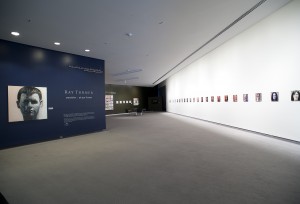Appreciating Face Time
May 2013 | By: Alice Mannette

WICHITA, KS.- Wichita Art Museum
Connecting people through their faces is Ray Turner’s mission. Turner, an accomplished artist, spends a day interviewing more than 20 subjects and snapping their pictures. He then goes back to his studio in California and takes out his oil paint and brush.
This February, he visited Wichita and set up a studio in a meeting room at the Wichita Art Museum. He asked for 20 people to come by, but he was so enamored by several Wichitans, he ended up with 28 portraits to paint. These 28 portraits were added to the show.
Each portrait is painted on thick, clear glass. But each background is a different color. Staff at each museum the exhibit visits must paint the 12-by-12-inch square a color designated by Turner.
Hardly any of the colors repeat themselves, said Patricia McDonnell, the art museum’s director. Because Turner wants a specific color, he uses a certain paint that is available across the U.S. and Canada.
“The hue that he chose in Pasadena is the same hue that you get in Wichita,” McDonnell said.
Turner also uses some of these colors to name his portraits: “Gentleman with Chocolate,” “Man on Slate Grey,” “Woman on Pale Sapphire Green” and “Young Lady with Pink.”
There are over 300 portraits in the exhibit, including the 28 from Wichita. Robin Macy, Tod Ernst, Mayor Carl Brewer, Bonnie Bing and Mike Michaelis represent some of the faces featured in this exhibit.
“He shows who we are as humans at this moment in the U.S. and how we tap into that through visual expression,” McDonnell said. “We are awash of all these different interesting characters.”
Turner believes a person’s face is a view into their soul.
“The face really tells you who the person is,” Turner said. “I am finding the beauty in each person.”
Sometimes Turner enjoys a particular face so much that he will paint it over and over again, getting more abstract with each rendition.
“I do enjoy meeting the people and discovering who they are,” Turner said. “When I find somebody that is particularly intriguing, I’ll wind up painting them two, three or sometimes 30 times.”
Each of these paintings forms an intriguing mosaic of color on the museum’s wall. The faces of young and old, black and white, male and female demonstrate the tapestry of America.
“I think this particular project has really captured a certain impulse in contemporary art work of democratic outreach,” McDonnell said. “While they are independent portraits, they are considered as the whole body of work.”